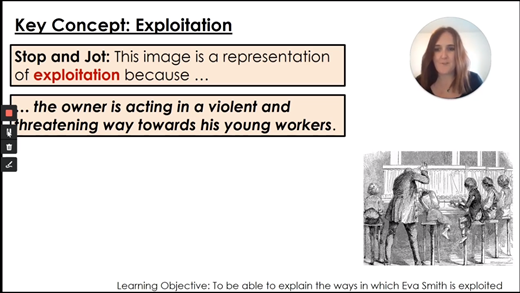06.19.20Marine Academy Plymouth’s Jen Brimming Models Implicit Accountability

Yesterday I blogged about one of Chloe Hykin’s lessons at Marine Academy Plymouth. Not only was it really well designed and implemented but it was clearly part of an intentional school-wide effort to produce consistent and high-quality Lessons.
Her response on Twitter was to share all of her peers’ work to share the credit.

In fact the whole gang at Marine Academy seem intent upon shining a light upon the work of their peers and showing how much the appreciate them. It’s one of the things I love most about teachers and schools, honestly.
Anyway, one of the lessons Chloe shared a clip of was this spectacular example her colleague Jen Brimming bringing a bit of what she called “Right is Right” to her lesson … and which I think is just as profound an example of implicit accountability–socializing students to self-assess against a model during online instruction. It’s both a necessity in asynchronous instruction and an opportunity to perhaps build student ownership of the learning process. But it’s hampered by the Dunning-Kruger Effect… novices don’t realize what they don’t realize. So if you say: “If your answer looked something like this, give yourself a check-mark,” the students whose answers look nothing like yours are likely to fail to perceive the difference. They’re likely to say, “Yup, that’s what I wrote.”
Anyway, Jen does a beautiful job of anticipating error and planning with that potential for mis-perception in mind. Here’s what she does:
When she asks students to self-assess, she says, “Let’s have a read of an answer I think some of you may possibly have written.” On her screen, she displays a response that she thinks students are likely to have come to—a solid start, but not a complete answer.
She says, “While this answer, I think, is mostly right, if we want to be on the path to university, we want it to be right right, so let’s have another look at the definition [of exploitation].” Instead of displaying the correct answer, like many teachers do in implicit accountability loops, Mrs. Brimming has chosen to highlight her anticipated student response, an answer that is on the right track, but doesn’t quite meet her exemplar. This allows her to give targeted feedback for revision, ensuring that students who have written something similar recognize the gap in their response.
Then, she rereads the definition of exploitation to students again, emphasizing both parts of the definition, and gives feedback for revision. She says, “So if you have an answer like this, you’ve done well in explaining how this factory owner is treating these workers in an unfair way, but we’ve maybe missed out how this would then benefit himself. So what we’d need to do to make this answer right right is to add something like this.” Then, she adds a second idea to her first response, a clear visual reminder of the importance of revision.
By breaking down the exemplar response into these two parts, she ensures that students who may have missed the second, subtler element can clearly see the gap in their understanding, and have the opportunity to revise their work and close that gap. She ends the review with an opportunity to rewrite, saying “If your answer doesn’t quite match that, get your green pens out and check that it covers both parts of that definition about treating people unfairly in order to benefit yourself. Pause the video now and have a check of your answer.” Revision is built into the class’s structure (there’s even a designated revision pen), creating a culture of self-assessment and student accountability.
Thanks again to everyone at Marine Academy for such thoughtful work. I’ve learned a lot from you all this week.
